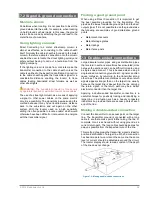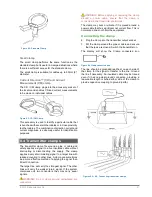
© 2015 Radiodetection Ltd
34
WARNING: Failure to follow the Tx-5 or Tx-10
instructions above may result in the tip of the FlexiTrace
becoming too hot to touch, resulting in risk of personal
injury and damage to the equipment.
The FlexiTrace can be used in two modes: Sonde mode
or Line mode. In sonde mode only the tip of the
FlexiTrace is energized whilst in line mode its whole
length is energized.
To use as a sonde, connect both transmitter leads to the
FlexiTrace stud terminals. As the FlexiTrace terminals
are not color coded it does not matter to which terminals
the leads are connected. To use the FlexiTrace in line
mode, connect the red transmitter lead to one of the
FlexiTrace terminals and connect the black transmitter
lead to a suitable ground connection.
8.6 Stethoscopes
When to use a stethoscope
At times, it may not be possible to put a clamp around a
cable
because
of
congestion
or
because
of
inaccessibility. A stethoscope antenna should be used in
place of a clamp to identify the target cable(s).
How to use a stethoscope
Plug the stethoscope into the locator accessory socket.
Press the concave head against each cable in turn to
detect a maximum signal.
Stethoscope range
Large stethoscope antenna
The large stethoscope antenna, which plugs into the
locator accessory socket, is used for cable identification
in situations where the cable is exposed. It is particularly
useful for identifying heavy cables lying in a tray where
it is not possible to fit a clamp. The concave detector
head on the end of the insulated, flexible gooseneck is
placed firmly against the cable to be identified. If there
are a number of cables, the stethoscope antenna will
give the strongest response from the cable to which the
transmitter signal has been applied.
Small stethoscope antenna
The small stethoscope antenna has a 25mm (2”)
concave head at the end of a 2m (6½ ft) lead. The small
stethoscope can be screwed into an extension rod or
used at the end of several extension rods joined together
for identifying inaccessible small cables.
Miniature hi-gain stethoscope
The miniature stethoscope is similar to the small
stethoscope but has no handle or facility for extension
rods.
The miniature stethoscope can also be used as a
miniature antenna for locations where the bulk of the
locator makes it inconvenient for use, such as locating
pipes or cables in walls.
CD stethoscope
In restricted areas, the CD stethoscope can be used to
obtain current direction but not current measurement.
8.7 Submersible antenna
When to use a submersible antenna
Tracing buried pipes and cables across waterways and
estuaries are frequent and critical locating applications.
Less frequent but equally important is tracing and
locating lines between the mainland and offshore
islands. When locating pipes and cables the locator
sensing antennas should be as close as possible to the
target line so it is not practical to locate lines buried
under a river or seabed from the surface. In most cases,
it is necessary to measure the depth of cover to ensure
the line is protected from dragging anchors or other
underwater hazards.
The submersible, double depth antenna is suitable for
use under water for tracing pipes or cables. There is a
weight at the bottom of the antenna for stability and the
unit has been pressure tested to IP68 to a depth of 100m
(300ft).
The antenna is supplied with 10m of submersible marine
umbilical cable as standard, but lengths of up to 100m
can be supplied. The extra length enables the antenna
to be carried by a diver on a riverbed or seabed while the
locator is used in a surface vessel. It is crucial to have
effective communication between the operator with the
locator and the diver with the antenna.
Alternatively the antenna can be fastened to the end of
a non-metallic boom from a barge and lowered to the
riverbed or seabed.
How to use a submersible antenna
Apply the transmitter signal to the target line at an
access point on the shore. The submersible antenna line
for tracing the line underwater is plugged into the
accessory socket of the locator. The locator is used
onboard a boat, which should by positioned directly over
40mm
Figure 8.11: FlexiTrace
8mm
40mm
































